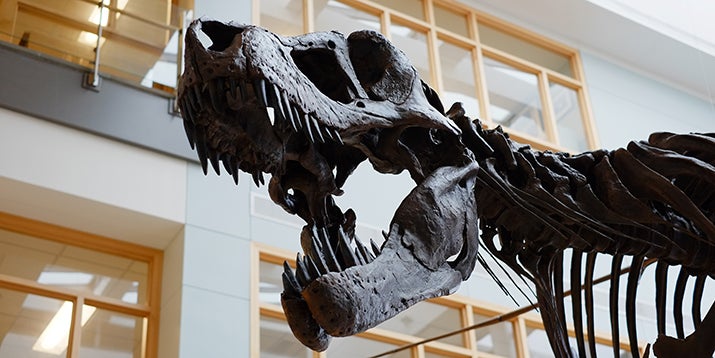By Becca Starkes
Phil Manning is a kid at heart.
Newly arrived to the College as a professor of paleontology and director of the Mace Brown Museum of Natural History, Manning tells the story of how he became fascinated by fossils. When he was 7 years old, he stepped into his backyard in rural Somerset, England, on what seemed to him a quiet, boring afternoon and began picking through the rock bed in his parents’ garden. He stumbled upon a rock with strange markings and indentations and, after asking his father and bringing it to a local museum for inspection, discovered he held a genuine fossil in his hands. The rest is history.
“I just didn’t believe you could do it as a career,” says Manning. “It was only later I realized, ‘My God, you can actually study this.’”
As it turns out, you can study it a great deal. Manning earned degrees in earth sciences (B.S.), geology (M.S.), and paleontology (Ph.D) from Leicester University, the University of Manchester, and the University of Sheffield, respectively. Before coming to the College, he taught and was director of a research center for 12 years in the School of Earth, Atmospheric and Environmental Sciences at the University of Manchester, where his wife, Victoria Egerton, is a research fellow. Manning and Egerton, who has also joined the Department of Geology and Environmental Geosciences as an adjunct professor, have conducted countless research projects related to paleontology and natural history. They are currently collaborating on a project with Stanford University examining dinosaur bones with X-ray light brighter than a billion suns.
Manning brings his passion to larger audiences through several television series — including National Geographic’s “Jurassic CSI” — and documentary films. He was even part of a team that won an Emmy last year in the category of Outstanding Science and Technology Programming for a film he contributed to called “Dinosaur 13.”
“I’ve been very, very lucky, insofar that I’ve been able to chart a career that has allowed me to study everything from the earliest mustering of life, some 3.6 billion years ago, through to human remains,” says Manning. Of all his projects, Manning most enjoys teaching public audiences about science and, hopefully, sparking in them the childhood curiosity that led him to collect fossils in Somerset all those years ago.
After filming episodes of “Jurassic CSI,” Manning and Egerton partnered with the Children’s Museum of Indianapolis on lectures, research, and field digs, and both Manning and Egerton became the museum’s Extraordinary Scientists in Residence for paleontology. During a recent visit, they spotted a lonely Tyrannosaurus rex hiding in a corner of the museum. Having just accepted their positions at the College, the couple thought “Bucky” the T. rex would be the perfect addition to the School of Sciences and Mathematics Building.
Watch a time-lapse video of the T. rex being assembled.
Soon after, Manning and Egerton found themselves caught up in the whirlwind of moving their lives halfway around the world and a 40-foot-long T. rex halfway across the country. Getting Bucky to the College wasn’t easy, but Manning and Egerton hauled him to the first floor of the Sciences Building where their dedicated colleagues from the Children’s Museum of Indianapolis and the College’s Department of Geology and Environmental Geosciences pitched in to help piece together the massive skeletal jigsaw.

“Bucky” the T. rex hovers over students in the lobby of the School of Sciences and Mathematics Building.
“I’ve only been here a week, and I have already had a perfect demonstration of how well the faculty here can work as a team,” says Manning. “That makes me feel warm inside.”
Bucky is on loan from the Children’s Museum for at least one year, with the potential for additional partnerships, loans, and excavations in the future.
Looking ahead, Manning hopes to collaborate with the Children’s Museum on new projects for CofC students, including possible dinosaur excavations during the summer. He believes this experience will inspire future paleontologists at the College. “If you say [to students], ‘Do you want to go dig [up] dinosaurs?’ there will be a snap of air and a vacuum where the person stood, because that’s what we want to do as paleontologists.”
And while the technical aspects of classifying dinosaurs might not initially seem thrilling, Manning says paleontologists manage to have plenty of fun in the process. One of his favorite traditions is nicknaming the dinosaurs he and his team discover, which nearly all paleontologists do nowadays. Rather than saying you’ve found MNJS PR7494, “it’s much more fun to say you’re digging up ‘Bob,’” says Manning. Our very own Bucky is named after the rancher who first stumbled across it back in 1998.
Manning views the loan arrangement with Bucky as a test-run for future collaboration and maybe even the acquisition of a dinosaur skeleton for the College to keep.
“Who knows? When we’re in the field digging dinosaurs this summer, we might just find a new species. I’d like to see Charlestonosaurus or something in the future.“
This article was written by Becca Starkes, a senior from Myrtle Beach, S.C., majoring in communication at the Honors College at the College of Charleston. She is also on the executive board of the Student Alumni Associates.







